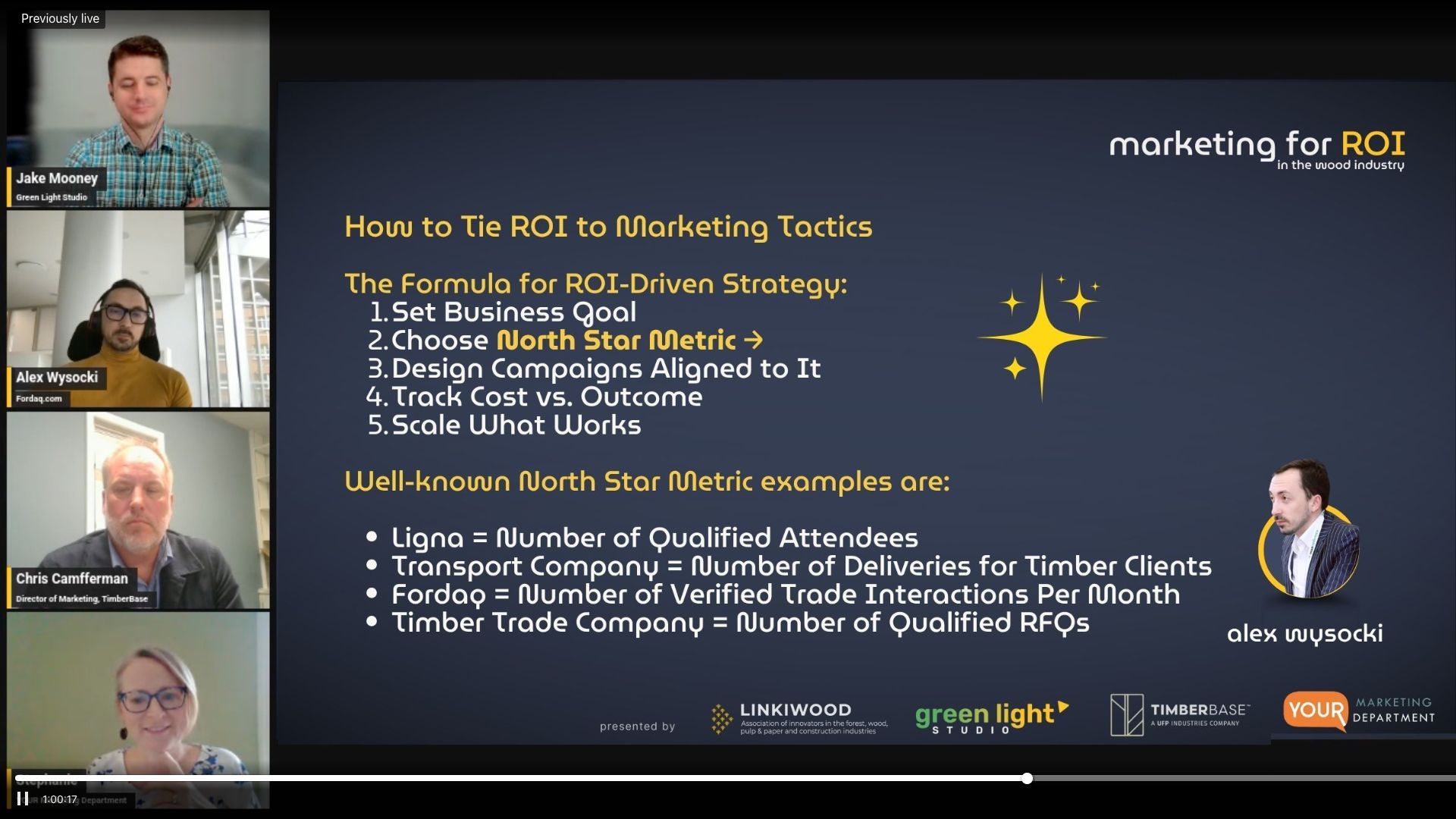
“Only a few report a clear, consistent strategy. Most feel overwhelmed or behind in their workload.”
– From a pre-event survey of marketing professionals in the wood products industry
If you’re responsible for marketing inside a timber or wood products company, chances are your day doesn’t feel strategic, it feels like a scramble.
You’re juggling last-minute trade show logistics, revising print flyers for the sales team, handling rushed website updates, and trying to prove that marketing is doing something to drive revenue. Meanwhile, the sales team is asking for new leads and wondering why marketing hasn’t delivered more yet.
Before the Marketing in the Wood Industry roundtable, we asked attendees what their marketing teams looked like and how they were feeling about their processes. The responses painted a clear picture:
- More than 70 percent of respondents had just one to five people handling all marketing responsibilities
- Only a handful reported having a clear, strategic marketing plan in place
- Most admitted they were stuck somewhere between “ad hoc” and “just reacting to what management or sales asked for”
That survey set the tone for a real, no-fluff conversation between four experienced marketing professionals in the wood industry. Together, they unpacked the shared struggles of under-resourced teams, unclear expectations, and what it takes to build a more sustainable marketing system no matter your company size.
What the Panelists Revealed About Overwhelming Expectations
Across the board, every speaker recognized a common theme: small teams are being asked to deliver big results, without the structure or resources to succeed.
Stephanie Rodrigue captured the pressure perfectly.
“You’re not just doing marketing. You’re supporting sales, managing customer relationships, handling content, and trying to keep leadership informed... all while trying to build something that actually works long term.”
The scope of responsibility is wide, especially for one- or two-person teams. Even in larger organizations, the perception can be misleading. Chris Camfferman explained that despite being part of a Fortune 1000 company, TimberBase’s marketing team is incredibly lean.
“People assume there's a full department because of the parent company. The reality is, it’s me. One person trying to juggle it all.”
The challenge isn’t just the volume of tasks, it’s the expectation that marketing can create fast wins without the foundational pieces in place. Alex Wysocki put it bluntly:
“Management wants fast victories. But without tools, budget, or systems, you're patching things together. You’ll burn out before you make it work.”
This kind of environment leads to burnout, frequent context-switching, and a sense that you’re always catching up, never building forward.
Absolutely. Let's build out this section using quotes verbatim from the transcript while anchoring each one in realistic narrative, examples, and meaning. The goal is to help overwhelmed marketers see why strategy always feels out of reach, and how they can begin reclaiming it with clarity and alignment.

Why Strategy Feels Out of Reach
If you're leading marketing in a wood products company, you've likely been told to "make it strategic." But what does that really mean when you’re buried in one-off requests, firefighting trade show needs, and managing a newsletter... all while trying to prove ROI?
For many companies in the timber and manufacturing sectors, strategy is an afterthought. Marketing isn’t brought in until the product is already finalized. Sales is already making calls. The campaign is already overdue.
Jake Mooney shared a story that summed up this common disconnect:
"In my previous years, there was an issue where we had branding issues. Marketing was like, hey, we have a solution. Management has decided to go in a different direction. Six months later, they found out how wrong they were."
Marketing teams often see problems coming. They propose solutions. But when management sees marketing as a service provider instead of a strategic partner, those early warnings are ignored, until it’s too late. As Jake put it elsewhere, “we had a plan” but were blocked from executing until the problem had already become visible to everyone.
Stephanie Rodrigue pointed to a deeper root cause: a fundamental misunderstanding of how buying has changed. Many companies in this industry still operate with a handshake mentality, assuming that relationships and reps do the heavy lifting.
But that’s no longer the case.
"Purchasers are not talking to sales people until they've done their own research. Up to seventy percent of the sales cycle is over before your sales rep is going to be talking to those people."

That shift means marketing has to work upstream, not downstream. If buyers are already forming opinions and shortlisting vendors before they ever engage with your sales team, then marketing must be involved early, helping shape those early impressions and pre-sale trust points.
Chris Camfferman spoke to how this plays out over time. Early in his career, he was stuck in reactive mode, doing what was asked, when it was asked. He shared:
"Early in my career, 80 percent of what I did was tactical and reactionary. Maybe 20 percent was strategic. The challenge is then to flip it to how do you get 80 percent strategic."
For many in the audience, that ratio will feel familiar. You may not have the capacity to stop reacting completely, but the goal is to slowly flip the balance. That means choosing what you focus on, building in rhythm and structure, and setting a measurable direction.
That’s where Alex Wysocki’s point comes in. Without a clear, company-aligned definition of success, marketing will always be chasing vague outcomes.
"If you’re an event organizer, it might be qualified attendees. For a trading platform, it might be verified interactions. Pick your metric and work backwards."
It sounds simple. But most teams never actually define what success looks like before diving into tactics. They launch campaigns before aligning on goals. That’s not a strategy, it’s a guess.
If you want to shift toward strategic work, the first step isn’t a calendar or a big planning session. It’s agreement on one key thing: what are we trying to achieve, and how will we measure it?
From there, everything else, your campaign calendar, your messaging, your tools, can fall into place.
Great. Here's a fleshed-out version of the next section using only verified, verbatim quotes from the transcript and building the narrative around them.

Why Marketing Feels Like a Silo
One of the most frustrating things for in-house marketers is the constant sense of being “apart” from the real business. You might sit in the meetings, get copied on emails, or be asked for support, but when it comes to key decisions, you’re not in the room.
That disconnect showed up strongly in our survey. Less than half of respondents felt their leadership saw marketing as a strategic function. The rest said they were treated more like a flyer factory, not a driver of growth.
Chris Camfferman voiced what many marketers feel but rarely say out loud:
"It’s funny. No one expects sales to do magic. But they expect miracles from marketing. Fast results, big ROI, no support."
That’s the pressure many small teams are under. You’re expected to create results without real input into the direction or budget. And yet, if things don’t land, it’s marketing that gets the blame.
Stephanie Rodrigue explained how this plays out in daily interactions:
"Marketing needs to understand the challenges sales faces every day... Sit in on cold calls... handling a customer issue..."
But her point wasn’t just that marketing needs to support sales. It’s that empathy has to go both ways. The best-performing teams break down the silos between departments by literally stepping into each other’s worlds.
Rodrigue encourages full-day “walk in their shoes” exchanges, marketers joining sales calls and cold calls, and sales participating in campaign planning and event logistics.
Without that exchange, mutual respect doesn’t form. Instead, marketing becomes the “make me a flyer” department, constantly fulfilling disconnected requests that aren’t tied to any shared goal.
Alex Wysocki challenged marketers to take responsibility, too. It's not just that marketing gets sidelined, it’s that marketers often lack visibility into how the company actually makes money. Without that context, it’s hard to contribute meaningfully to strategic decisions.
"If you don’t understand how your company makes money with pricing, margins, delivery, then you can’t do effective marketing. You’re just guessing."
This is the unspoken gap. Marketing that looks good but misses the mark happens when the team doesn’t know the numbers. What is the sales margin? What’s the delivery bottleneck? What’s the lifetime value of a new account?
Bridging this gap isn’t about forcing collaboration, it’s about building trust, showing business fluency, and tying marketing efforts directly to outcomes that matter to sales and leadership.
And when that happens, marketing stops being a silo. It becomes a partner.

What Small Teams Can Actually Do
When your marketing team is just you, or maybe you plus one, it’s easy to feel like strategy is a luxury you can’t afford. But the panelists offered a different view: small teams can do strategic work, as long as they’re focused.
The key is to stop trying to do everything. Instead, start doing the right things well, consistently.
Chris Camfferman suggested beginning with what sales is already struggling with:
"Ask your sales team what customers are getting stuck on. Then build tools to remove those blocks."
That advice cuts through the noise. Instead of inventing new initiatives, start by asking: where are buyers stalling out? Maybe it’s unclear pricing, missing documentation, or poor follow-up. Solve that, and you immediately increase sales performance without adding complexity.
Stephanie Rodrigue echoed this approach and emphasized the importance of prioritization:
"I recommend usually if you have a very small team, stick with three or four marketing goals a year, but make them high impact."
She pointed out that overwhelm often comes from spreading yourself too thin. You don't need twelve channels running at once. You need two or three that are actually working. Clean sales sheets. One solid customer email per month. Real product photos.
Jake Mooney added that structure is what keeps small teams from burning out:
"If it’s not repeatable, it’s not sustainable. Start small but repeat it until it becomes a system."

That’s how real momentum is built, not by doing more, but by doing less with greater consistency. For example, a simple monthly rhythm (maybe one email, one new sales tool, and one internal touchpoint, ) can build trust and results over time.
Alex Wysocki encouraged teams to look outside their own bubble, too:
"Follow UFP Industries. Follow your biggest competitors. Don’t copy them, but learn from what they’re investing in."
That might mean updating your spec sheets, streamlining your quote process, or simplifying how product info gets to dealers. Watch how market leaders solve real business problems and ask: how could we adapt that?
The message across the board: you don’t need a big budget to build real systems. You need clear priorities, a rhythm you can sustain, and a focus on what actually helps sales and customers move forward.
Real Fixes, Not Magic Tricks
It’s tempting to think that solving marketing overwhelm means hiring a big team or launching a massive rebrand. But every speaker in the roundtable pushed back on that idea. The real fix? Practical systems, built at the scale you can actually maintain.
Jake Mooney shared an example of a solution that started small and ended up changing how his company was seen internally:
"We created a simple newsletter because no one else was talking to the dealers. Six years later, it became one of the most relied-on tools in the company for internal communication."
It wasn’t flashy. It wasn’t a major investment. But it solved a real problem and kept solving it over time. That consistency earned trust. It also shifted how management viewed marketing, not as the “make it pretty” department, but as a partner who solves business challenges.
That’s the pattern that kept showing up throughout the discussion: impact builds credibility. And impact comes from being aligned with sales, operations, and management on what actually matters.
Stephanie Rodrigue emphasized that alignment starts with shared understanding:
"Walk a mile in their shoes. Sit in on cold calls. Help with pricing objections. Then they’ll start showing up when you need their buy-in."
When marketing understands the real pain points of sales and customers, and contributes to solving them, internal support and visibility follow naturally.
You don’t need a rebrand. You need to help the business win. That’s what makes marketing visible, valued, and trusted.

You’re Not Alone, and You’re Not Failing
If your day-to-day in marketing feels chaotic or reactive, you’re not the only one. The speakers, and the survey data, made it clear: this is normal right now in the timber and wood manufacturing space.
Most marketing teams are small. Most are overwhelmed. Most are still trying to find their rhythm between random requests and long-term strategy.
That doesn’t mean you’re doing it wrong. It just means you need a simple system that works at your company’s size.
One weekly rhythm. One go-to-market plan. One measurable goal that actually tracks progress. That’s how you start.
Chris Camfferman put it plainly:
"Marketing isn’t about magic. It’s about alignment. And once you have that, everything gets easier."
So if you feel behind or stretched thin, step back. Look at where the business needs to win, and start there. Show up with solutions, keep showing up with consistency, and the perception of marketing will begin to shift.
You don’t need a bigger team to make that happen. You just need a better system, and a seat at the table to help shape what matters next.
Unimpressed with your marketing?
Get support and direction with these resources:
- Free Marketing Audit Workbook - Download Now
- Subscribe to Our YouTube Channel - Subscribe
- Get a custom strategy for your business - Get In Touch
- Connect with Jake on LinkedIn - Connect
Unimpressed with your marketing?
Get support and direction with these resources:
- Free Marketing Audit Workbook - Download Now
- Subscribe to Our YouTube Channel for practical marketing tips and strategies. Subscribe
- Contact Us - Let’s create a custom strategy for your business. Get In Touch
- Connect with Jake Mooney on LinkedIn - Connect
Why Most Wood Industry Marketing Teams Feel Overwhelmed and How to Fix It











